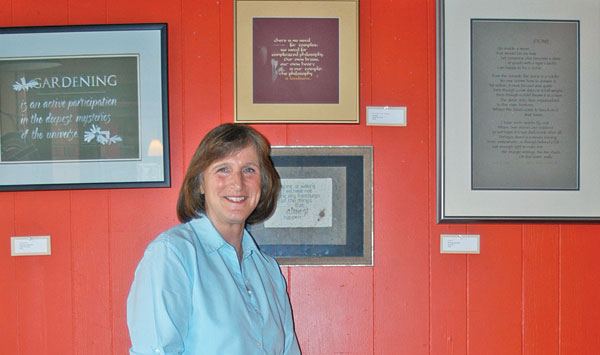by ASHLEY MILLER
for the Sequim Gazette
Susan Moss Blenk has a way with words.
Or letters, that is, to be exact.
From the time she could first hold a pen in her hand, Blenk has been interested in the art of handwriting.
In high school and college, she would trace artistic letters from magazines onto envelopes and send them to friends.
Something about calligraphy and the structure of each individual letter caught Blank’s attention and has continued to fascinate her for more than 40 years.
“Calligraphy isn’t just ‘fancy writing,’” Blenk insisted.
“It is based on reproducing historical alphabets which follow strict rules (and) once one has a good foundation and understands how those alphabets are formed, then one can play with them.”
For Blenk, the pleasure of calligraphy comes with the interpretive ability of the craft.
“Words convey meaning and can create images but calligraphy adds depth to those words,” she explained. “I enjoy the lyrical movements of the letters, the dance.”
Since girlhood, Blenk has been collecting quotations, writing them on index cards and categorizing them. She uses the memorable and meaningful words of others to create a unique art form.
Inspiration comes to Blenk from the world around her: the grace and colors of nature … light … images that authors can create with their words.
“I am lucky to be able to interpret that with calligraphy,” she said.
More often than not, curious people will ask her how the advent of the computer has affected her career as a calligrapher, Blenk said. The answer, she continued, is that it hasn’t.
Can computers do what calligraphers do? Sure, Blenk conceded. Generic awards and certificates are definitely more easily and inexpensively created on the computer. But, she argued, calligraphy is different.
“Calligraphy incorporates the human element,” Blenk said. “Each letter is free of the structure imposed by forms of mechanized lettering. It can interpret and enhance the written words; it can evoke feelings separate from the words themselves.”
That is what is gratifying about calligraphy, Blenk said confidently, and it can’t ever be replaced by a machine.
During the 1980s, Blenk lived in Seattle and ran a graphic art and design business. When she moved to Sequim in 1986, she put calligraphy on the back burner and joined her husband, now deceased, in his woodworking business.
Now Blenk works part time at Costco and does calligraphy more for enjoyment than income.
“Since I am not dependent on calligraphy for my livelihood, I am free to create pieces that make me happy and not necessarily those that I think will sell well,” she said.
“My work at this point is entirely comprised of original artwork (though) I have to be careful of copyright issues in choosing the quotes I have for sale, as the original author’s work must be respected.”
Creating with
the scribes
Blenk is a member of the Peninsula Scribes and meets with fellow calligraphers the second Friday of each month at the Parkwood Community Center. She recently participated in a class through the club taught by California calligrapher Sylvia Kowal, where she learned new techniques using walnut ink rather than her usual gouache — a highly pigmented watercolor.
Peninsula Scribes regularly sponsors classes and workshops with well-regarded calligraphers to foster a better understanding of the craft.
Some of Blenk’s work is included in the “Letter of Joy,” a permanent exhibit of calligraphy pieces sponsored by Write on Calligraphers of Edmonds.
Her work also is on display at The Buzz coffeehouse through the end of the month.
“It’s a little different than ‘normal’ artwork and you have to spend some time reading off the walls,” she said. “I think people will enjoy the exhibit because, if I have done my work well, it will make them smile and make them sigh and maybe make them shed a tear or two. But mostly smile.”



